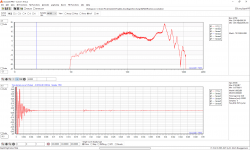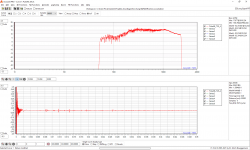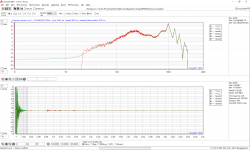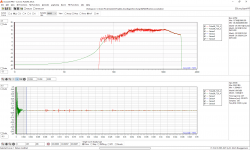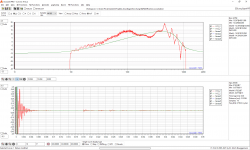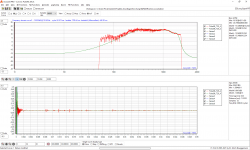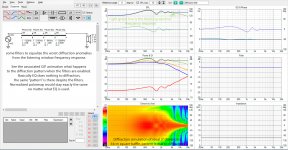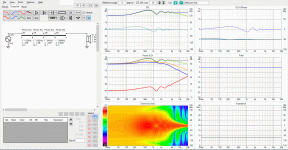You are right. For a productive, "mature" multiway system there should indeed be no need for an additional, overall convolution including the whole system. By the way my final multiway system had no overall filtering.
But overall convolution is a nice option: I wrote this stuff about the overall filtering/convolution from a reality as an ever-tweaking DIY-er: Whenever I changed someting with the baffle e.g. while tweaking for an improved polar behavior, it was more convenient to change one single overall filter than three filters for the distinct ways.
And by the way: I always null out the part of the measured impulse containing room information, in order to simulate an anechoic condition. I want to influence on the speaker, not on the speaker withing my test surrounding. The corresponding loss of information for the lower frequencies can then be synthesized by appropriate models. And neither for dayly listening I would include the room response within any DSP. Because it completely messes up the direct sound.
I think we are very much in agreement.🙂
You may instead very well improve on diffraction artefacts within a specific compartment of the space by DSP. E.g. by averaging some measures from out of the compartment where later some ears might be listening to audio material. And then build a filter from this average. Knowingly that then you encounter the holy mess of compromising, instead of reaching perfection. Hopefully compromise for the better, because you can also perfectly mess up things by DSP if you don't know what you are doing.
All this is not a flaw of convolution and DSP as such. That's audio in space ... Compromising ... Such is life ...
Exactly!, we are indeed very much in agreement.
Hi, yeah if the head is moving I'd expect more changing sound with EQ than without EQ compensation for the diffraction. But, if the head is always at the listening spot, maybe there is some benefit especially if the speakers have relatively high directivity and the timedelay between driver and baffle edge is small. If it is small room with wide directivity speakers I'd expect the power response anomalies will be very much audible. Any EQ at cost of power response is only going to harm the sound I'd say.
Anyway, way better idea is to address acoustic problems like diffraction with acoustic (baffle) design and not even consider EQ to address it, unless there is nothing one can do about it.
My intuition says small baffle = better since less time delay (from driver to the edge). Freestanding waveguide seems best covering bandwidth as low as possible, to as high one wants speaker response to get. No diffraction or any other acoustic problems (in the simulations, ATH thread) so EQ can do the job and make the speaker very much perfect. Until the room and stuff at home ruins it 😀
Edit. A MEH could play as low as possible. Even though the midrange taps will introduce some diffraction I think it won't be as audible as with any speaker baffle. Taps are very small compared to a baffle edge and have very short or no delay(?) compared to the direct sound. Make very good mouth termination and there is no "baffle edge". I've never build any yet, this is just my thought experiment.
Anyway, way better idea is to address acoustic problems like diffraction with acoustic (baffle) design and not even consider EQ to address it, unless there is nothing one can do about it.
My intuition says small baffle = better since less time delay (from driver to the edge). Freestanding waveguide seems best covering bandwidth as low as possible, to as high one wants speaker response to get. No diffraction or any other acoustic problems (in the simulations, ATH thread) so EQ can do the job and make the speaker very much perfect. Until the room and stuff at home ruins it 😀
Edit. A MEH could play as low as possible. Even though the midrange taps will introduce some diffraction I think it won't be as audible as with any speaker baffle. Taps are very small compared to a baffle edge and have very short or no delay(?) compared to the direct sound. Make very good mouth termination and there is no "baffle edge". I've never build any yet, this is just my thought experiment.
Last edited:
This might be misleading.tmuikku said:...if the head is moving I'd expect more changing sound with EQ than without EQ compensation for the diffraction ... Any EQ at cost of power response is only going to harm the sound I'd say.
Perception in general is all about change (delta(I)) versus time (delta(t)). And this also goes for psychoacoustics. And we are talking about moving one’s ears in an acoustic space, where every point of this space may be different in terms of it’s acoustic content. So while moving, there always will be delta(I) vs. delta(t).
Example I:
DSP has been applyied so that there is a perfect or near perfect solution in a very narrow subspace - this is what you may talk about. This optimized space is inherently so narrow, that every move of your head violates it’s boundries. If then you unavoidably move out of this subspace, you will psychoacoustically encounter a distinct change from good to flawed. Even if all locations next to this highly optimized subspace still provide a quite good solution, and a better one if there was no DSP at all. You will then interprete this quality step as a messed up solution because of DSP. Because your perception is in terms of a delta(I) vs. delta(t) mode and delta(t) while moving is tiny.
Example II:
Decent DSP has been applyied to provide a 3d array of knowingly, slightly flawed solutions instead, but for a much wider subspace. You will be moving around freely in this space, from very well compromised solutions to others very well compromised solutions. You will much better tolerate the changes of quality than in Example II. Still, you will be able to listen to audio material for quite long perdiods without being annoyed.
Example III:
No DSP at all. Basically same as II, except that there is no optimized hearing zone. And probably everywhere on an overall lower level. Worst-case, long term auditions even might get gruelling.
The Amplifier Institute Canteen.
Example IV:
DSP in a typical setup of the enthusiastic and enchanted beginner mode. +14.7dB @ 241Hz to counter for the floor reflection, +7.2dB @197Hz to counter for the ceilings reflection, -6.8dB @ 76Hz to counter for the first room mod… Selectively listening to slow sine sweeps at the sweet spot, this indeed will provide an enchanting audio experience ... And do not forget the option to add some +5.3dB @ 14.657kHz to counter your presbyacusis.
Last edited:
If considering only the diffraction sound is already compromised over a zone and EQ would just make that compromise different. Much better choice would be to utilize better acoustic design leaving the EQ more effective correcting the remaining issues.
Of course the loudspeaker driver problems can and should be EQd but not the diffraction so we might think about the same stuff but have different perspective how to look at the situation? You seem to describe power response equalization ( EQuin to a zone ), which is a good thing, but I get a feeling you are also trying to EQ the diffraction effects?
Edit. I don't want to argue, just trying to reach to an understanding so that other readers don't get confused as I have 😀
Of course the loudspeaker driver problems can and should be EQd but not the diffraction so we might think about the same stuff but have different perspective how to look at the situation? You seem to describe power response equalization ( EQuin to a zone ), which is a good thing, but I get a feeling you are also trying to EQ the diffraction effects?
Edit. I don't want to argue, just trying to reach to an understanding so that other readers don't get confused as I have 😀
Last edited:
Is diffraction time-variant? I can't see how.
What are the "some of these behaviors" referred to in the Abstract, that are time-variant, nonlinear, or spatially variable?
Exactly what behaviors that can't be corrected?
They certainly exist; let's just pls try to make sure we are clear on what can and cant be corrected.
Also, please note your 'in the conclusion' quote refers to transducer designers.... which imho, is saying they do not fully understand the end game.
If anything, that quote supports the efficacy of correction capability, saying transducers designers need to see past the usual uncorrected frequency response measurements..
I do get diffraction is spatially variable. And that spatially variable is simply not even close to being completely correctable with DSP.
That said, what i continue to measure and hear, is that the portion of diffraction that directly hits a fairly wide listening window, is absolutely improved by correcting it.
The dispersed diffraction, the uncorrectable spatial diffraction, the diffraction heading off into the room to be reflected back into the direct listening window ......
......is low enough in magnitude and audibility, that i think it becomes a big relative 'so what'.
Spatially means "in different places" as in a 0,30,60 deg spinorama diagram - you cant with a DSP correct a bad looking 30 deg curve at the same time preserve the ones at 0 and 60. Read this again - this is the essence of what my comment was about!
//
This might be misleading.
Perception in general is all about change (delta(I)) versus time (delta(t)). And this also goes for psychoacoustics. And we are talking about moving one’s ears in an acoustic space, where every point of this space may be different in terms of it’s acoustic content. So while moving, there always will be delta(I) vs. delta(t).
My experiences listening to speakers that sound good only when the head is in a vice were with negative feelings but they were more than 20 years ago. I think it was not because of delta(t) but because the designers focused on the on-axis performance only so that off-axis performance was suffering (e.g. forcing wide woofer to marry a high directivity tweeter).
I think its okay if on-axis is suffering a little (e.g. peaky) as long as we have wider good quality off-axis. But well, even today people are still using listening chair (in a triangular position with the speakers).
But this also tells that DSP cannot solve important issues (when in agreement that off-axis performance is the one that matters).
... Much better choice would be to utilize better acoustic design leaving the EQ more effective correcting the remaining issues ...
... Of course the loudspeaker driver problems can and should be EQd but not the diffraction ...
Partially a conditional yes to the first statement. Only partially, because EQ does not "wear out" correcting "remaining" issues. These would be issues belonging to sound source, aka the driver(s) and the mechanical setup surrounding it: Either in a minimal design some strings and wires for an all naked dipole setup, or a box construction.
And then a distinct no to the second statement. Mission impossible. How would you selectively correct for the driver, but not for the baffle diffraction? Have an educated look at the following graphs:
It's two measurements sets. Once for an Excel W12CY001 Midrange and then for an Excel T29M001 tweeter. Both sets include
1_Long:
Red is the first part of the impulse with a long truncaton, roughly including every echo within a time lag corresponding to 15m. So including the room where the measurement took place.
2_No_Floor:
Red is as above.
Green is the the first part of the impulse truncated so to exclude any room influences (a time lag corresponding to sound travelling for 1m, e.g. excluding the floor reflection)
3_No_Baffle_Diffraction:
Red is as before.
Green is tuncated to a time lag of corresponding to a circular baffle of r=11.23cm. Therefore, with this truncation, you will null the baffle diffraction. And now look at the frequency domain window: You will see that trying to generate such a ridiculously short filter, which would exclude the baffle diffration, would come along with quite absurd results. Even for the tweeter case. Nota bene: This would generate quite an effective filter. But a filter simply not suited for regular audio.
So the two take home message would be:
- You will always influence on the baffle diffraction effects when filtering a driver by this method of DSP
and in the reversed logic
- You cannot selectively exclude baffle diffraction effects when filtering a driver.
If you want to stick to controlling the driver but not the baffle diffraction by DSP at the same time, then you have one possibility left: You can make your baffle really wide. There you go. Speaking of meters, then ....
Attachments
Last edited:
If considering only the diffraction sound is already compromised over a zone and EQ would just make that compromise different. Much better choice would be to utilize better acoustic design leaving the EQ more effective correcting the remaining issues.
Of course the loudspeaker driver problems can and should be EQd but not the diffraction so we might think about the same stuff but have different perspective how to look at the situation? You seem to describe power response equalization ( EQuin to a zone ), which is a good thing, but I get a feeling you are also trying to EQ the diffraction effects?
Edit. I don't want to argue, just trying to reach to an understanding so that other readers don't get confused as I have 😀
Completely agree that best solution is always a perfect acoustic design.
Which we all know, audio being audio, is a unicorn.
So we likely end up needing some form of EQ in our finished designs.
If we apply any EQ at all, i think we end up EQ'ing diffraction whether we realize it or not.
Because when we measure a loudspeaker, how do we separate part of the measurement that is due to direct sound, and the part that is from diffraction? Gating can't do it...propagation times are too close together.
I don't know it can be realistically separated.
So if I make any EQ adjustments off the measurement, how can I say what part i'm actually countering?
Even if i simply adjust tone by ear, using whatever kind of dial-an-EQ,
how do I know exactly what is causing the tonal imbalance i wish corrected.
Is it the direct driver or diffraction?
So if I make any EQ adjustments off the measurement, how can I say what part i'm actually countering?
How about removing the room effect, either by bringing the speaker outside (some kind of anechoic chamber) or covering all the wall and floor with suitable material?
If you are EQing by ear until it sounds correct, and if it is not caused by one of these problems, then it should also correspond with the mesurement. The amount of EQ accepted was the same as the size of the peak. Keep in mind though that not all diffraction shows up much as response, and the differences in a venue with fewer reflecting surfaces.Even if i simply adjust tone by ear, using whatever kind of dial-an-EQ,
how do I know exactly what is causing the tonal imbalance i wish corrected.
Is it the direct driver or diffraction?
Using just a response measurement? Not easy.How would you selectively correct for the driver, but not for the baffle diffraction?
#608, Aha! You are talking about temporal EQ stuff I was still on the IIR EQ. Windowing (truncated time) is exactly how would one measure problems on the loudspeaker leaving the room out. Diffraction is contained within the measurement window but when one does full "spinorama" measurements and simulation diffraction effects are pretty easily spotted from the polar /power, as in the VituixCad example I posted earlier with ideal driver on a baffle simulation. With such information the diffraction can be ignored while designing an EQ or crossover.
I still think we are mostly speaking about the same stuff but there is still some confusion, at least I believe so. I try explain my point of view once more 😀
For example this is wrong statement or wrongly written thought (or I'm misunderstanding):
"
- You will always influence on the baffle diffraction effects when filtering a driver by this method of DSP
and in the reversed logic
"
since no matter what the driver response is the baffle diffraction adds precisely the same effect to the output at given mic position regardless what the driver output is (what ever EQ).
Example: If there is dip on 1.5kHz at 2 meters away 17 degrees left from the axis, compared to a location next to it, the dip will always be there (due to diffraction superimposing to the direct sound) no matter what the frequency response of the driver is. Now if you want to have that dip disappear at that spot with EQ you boost the 1.5kHz either with IIR ( or FIR with "countersmear" ) to the direction ( and location ) but you end up boosting the 1.5kHz everywhere else so the dip still remains comparing to spot next to it we compared before the EQ. Only thing one can actually do to fix the dip, between these measurement spots, is to make the diffraction disappear = change the physical acoustic properties of the loudspeaker.
I'm not sure if you can convince me to think otherwise but you can try 😀 I'll read at least. These are fun things to think about, very complex stuff.
I still think we are mostly speaking about the same stuff but there is still some confusion, at least I believe so. I try explain my point of view once more 😀
For example this is wrong statement or wrongly written thought (or I'm misunderstanding):
"
- You will always influence on the baffle diffraction effects when filtering a driver by this method of DSP
and in the reversed logic
"
since no matter what the driver response is the baffle diffraction adds precisely the same effect to the output at given mic position regardless what the driver output is (what ever EQ).
Example: If there is dip on 1.5kHz at 2 meters away 17 degrees left from the axis, compared to a location next to it, the dip will always be there (due to diffraction superimposing to the direct sound) no matter what the frequency response of the driver is. Now if you want to have that dip disappear at that spot with EQ you boost the 1.5kHz either with IIR ( or FIR with "countersmear" ) to the direction ( and location ) but you end up boosting the 1.5kHz everywhere else so the dip still remains comparing to spot next to it we compared before the EQ. Only thing one can actually do to fix the dip, between these measurement spots, is to make the diffraction disappear = change the physical acoustic properties of the loudspeaker.
I'm not sure if you can convince me to think otherwise but you can try 😀 I'll read at least. These are fun things to think about, very complex stuff.
Spatially means "in different places" as in a 0,30,60 deg spinorama diagram - you cant with a DSP correct a bad looking 30 deg curve at the same time preserve the ones at 0 and 60. Read this again - this is the essence of what my comment was about!
//
Sure, i gathered you were primarily talking about spatial variance....that's why i wrote so much to specifically address spatial variance.
"I do get diffraction is spatially variable. And that spatially variable is simply not even close to being completely correctable with DSP.
That said, what i continue to measure and hear, is that the portion of diffraction that directly hits a fairly wide listening window, is absolutely improved by correcting it.
The dispersed diffraction, the uncorrectable spatial diffraction, the diffraction heading off into the room to be reflected back into the direct listening window ......
......is low enough in magnitude and audibility, that i think it becomes a big relative 'so what'."
To repeat what has been well said by Daihedz, the trick to using DSP correctly for treating diffraction, horn reflections, etc....is to spend time looking at the effect of EQs on all the polar angles, and choose the set that provides the best overall balance. It's definitely a trick worth leaning imo/ime.
The +/- 20 degree window is what I primarily optimize to.
But I've also found i can significantly effect a 30 degree response anomaly, and keep the impact minimal on 0 degrees. Usually what helps at 30 degrees, also helps at 60 degrees.
Quick animation, same diffraction simulation as last time back in post #567. This time the directivity window is set to polarmap instead of surface chart like last time. One file contains the legend and the other is a GIF animation that is attempt to show that no EQ will change the underlying pattern diffraction imposes on the loudspeaker response.
The EQ filters make listening window response (= listening zone) more flat but the inroom (power response) suffers and the diffraction is still the same. I could put normalization on for the directivity window but that would give the same (unchanging) view no matter what EQ is applied.
The EQ filters make listening window response (= listening zone) more flat but the inroom (power response) suffers and the diffraction is still the same. I could put normalization on for the directivity window but that would give the same (unchanging) view no matter what EQ is applied.
Attachments
Last edited:
How about removing the room effect, either by bringing the speaker outside (some kind of anechoic chamber) or covering all the wall and floor with suitable material?
Hi, the room effect hasn't really been the topic of the EQ talk (mine at least).
Topic has been, can diffraction that comes off of the speaker be successfully EQ'ed.
Diffraction exists even in anechoic conditions, outdoors, etc, because it comes from the speaker itself. Not from room reflections.
The portion of the diffraction that heads straight to the mic from off of the speaker, will be a part of a measurement, even in anechoic conditions.
That 'bee-line to mic diffraction' will sum together with the direct speaker response to form the measurement.
This is the part of diffraction i feel is a candidate for 'delayed-in-time', dsp correction. And I've had good luck doing so.
Hope that made sense...and hope you can see it's not about getting the room out of the way...
Hi, the room effect hasn't really been the topic of the EQ talk (mine at least).
Topic has been, can diffraction that comes off of the speaker be successfully EQ'ed.
"Because when we measure a loudspeaker, how do we separate part of the measurement that is due to direct sound, and the part that is from diffraction?"
The baffle HF diffraction is part of the direct sound, why do you want to separate it? The issue is with off-axis LF diffraction that has time delay issue.
Here few other quick examples what happens to diffraction with added roundovers.
3 GIF:s are made with VituixCAD diffraction simulator. All square, 3" ideal driver at center, mic at center 3m distance. 11cm, 22cm and 44cm square baffle. All have first image with 0mm roundovers, then 25mm radius, 50mm, 100mm and 150mm. The smallest one has only the few first etc.
Some things that caught my eye
1. there is no baffle diffraction at high frequencies where the driver response is beaming
2. roundovers need to be larger with wider baffle to have similar amount of ripple reduction on the on-axis frequency response, about half width radius (round baffle) to get smooth on axis response
3. roundovers direct more energy back / sides of the speaker (at low frequencies)
Sorry there is no legend in the GIF files and they were too big to be attached here..
11cm square baffle - roundovers.gif
22cm square baffle - roundovers.gif
44cm square baffle - roundovers.gif
3 GIF:s are made with VituixCAD diffraction simulator. All square, 3" ideal driver at center, mic at center 3m distance. 11cm, 22cm and 44cm square baffle. All have first image with 0mm roundovers, then 25mm radius, 50mm, 100mm and 150mm. The smallest one has only the few first etc.
Some things that caught my eye
1. there is no baffle diffraction at high frequencies where the driver response is beaming
2. roundovers need to be larger with wider baffle to have similar amount of ripple reduction on the on-axis frequency response, about half width radius (round baffle) to get smooth on axis response
3. roundovers direct more energy back / sides of the speaker (at low frequencies)
Sorry there is no legend in the GIF files and they were too big to be attached here..
11cm square baffle - roundovers.gif
22cm square baffle - roundovers.gif
44cm square baffle - roundovers.gif
Last edited:
"Because when we measure a loudspeaker, how do we separate part of the measurement that is due to direct sound, and the part that is from diffraction?"
The baffle HF diffraction is part of the direct sound, why do you want to separate it? The issue is with off-axis LF diffraction that has time delay issue.
Diffraction come from edges - how can then direct sound contain anything from diffraction? My definition of direct sound is: a wave front hitting my ear without having done a bounce on any wall. In any circumstances, energy effected ny diffraction hitting the ear will always be later than the non diffracted. How long is your time window?
//
Because it sounds bad - believe me. I tried to be in a room with super amounts of damping.... sounds too dull.... and you dont want to live like imprisoned in a rubber cell 😉How about removing the room effect, either by bringing the speaker outside (some kind of anechoic chamber) or covering all the wall and floor with suitable material?
Diffraction come from edges - how can then direct sound contain anything from diffraction? My definition of direct sound is: a wave front hitting my ear without having done a bounce on any wall. In any circumstances, energy effected ny diffraction hitting the ear will always be later than the non diffracted. How long is your time window?
If that's the definition of direct sound then fine. I didn't understand why it should be separated from direct sound from the cone.
The effect of this diffraction due to baffle edge of the tweeter is small (with non symmetrical positioning of the tweeter). If anyone think the effect is huge, please tell me how do you perceive the difference. Off-axis and LF time delay issues are much bigger.
- Home
- Loudspeakers
- Multi-Way
- World's Best Midranges - Shocking Results & Conclusions.
